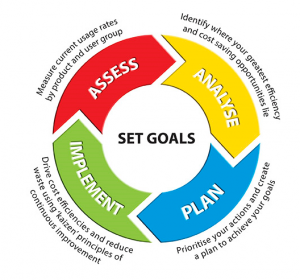Do you know that in the IT industry, there is NO benchmarking, NO common metrics used and NO best practices amount the usage of software license? Organisations would often find it very costly to engage with consultants to set up usage measurement and with little benefit of understanding the software usage and data generated.
Anyone working in product management or manufacturing will have been exposed to Kaizen, or “continuous improvement” practices from an early stage in their career. This management philosophy was first implemented in a number of Japanese organisations after the Second World War and led to the rapid growth of Japanese manufacturing in the latter part of the twentieth century. Discipline and focus improved the quality of output and the reduction of inefficiencies reduced the overall cost of production.
Does it mean we can apply Kaizen techniques into software usage? Of course yes, but most SAM practitioners are not utilising Kaizen techniques to deliver efficiency benefits to their organisations.
At the heart of all Kaizen process is a “control cycle” or “wheel”. This sets four actions around an objective in the form of a continuous process as presented in the diagram below:

Kaizen Process for Software Usage
For software asset management and software efficiency, the cycle is set with the following components:
1. Objectives. This forms the centre of your wheel and you can attach quantifiable targets to your goals such a savings value of £50,000 over the next 12 months or increasing overall usage of software assets from 64% to 85%. You may need to do some research to set your goals as you can’t really set a valid goal unless you know where you are starting from.
2. Assess. This stage is basically measuring your current software usage rates as a percentage of what you are licensed to use. Ideally this should be done by software title and types or groups of users.
3. Analyse. Your next stage is to identify where your greatest cost saving and efficiency opportunities lie. You can do this by attaching a monetary value to your over or under-licensing levels for each software title and then ranking them by value. You will soon see where the greatest opportunities lie.
4. Plan. Prioritise your actions based on the best opportunities and create a plan to achieve the goal. Your goals or targets should be achievable within the timescales you have set to reach them.
5. Implement. Now it is time to implement your plan and perform the actions required to deliver the goals you set. Make sure you implement quickly and measure the results constantly.
Once you have been round the steps once then do it again. Measure where you are now and what improvements have been made and then set new goals, analyse, plan and implement again. Kaizen is about continuous improvement so you keep going round the circle and measuring improvements as you go. By working this way you will be able to gauge the impact of your work, reduce costs and improve compliance over time. Your work will be focussed, structured and the results will be visible for all to see.
If you would like to see how you can implement Kaizen processes in Software Asset Management, TBSC would be happy to show you. We have created a series of graphs and charts utilising data from our software usage meter – Rentsoft Meter – to enable our customers to make continuous improvements in the management of their software assets. Complete our enquiry form at here.